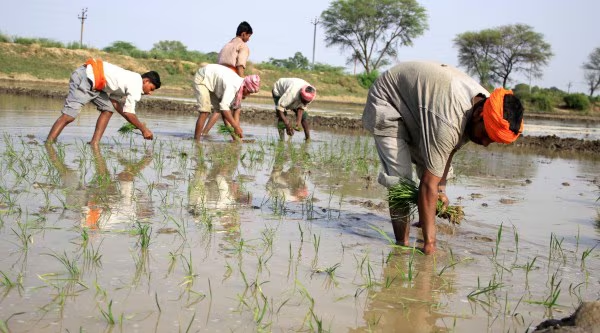CHANDIGARH: Already reeling from a depleting groundwater table, Punjab is now staring at an unprecedented groundwater crisis, as the state’s decision to advance paddy transplantation dates has triggered excessive water extraction—pushing its fragile ecology to the brink. Due to the longest dry spell recorded in June, the decision to advance paddy transplantation has resulted in excessive groundwater withdrawal, as farmers struggled to keep their crops alive. With little to no rainfall, farmers have been heavily dependent on groundwater and have resorted to diesel-powered pumps to meet irrigation needs.
According to rainfall data from the Indian Meteorological Department, half of Punjab has experienced “Large Deficient” or “Deficient” rainfall in June, with eight districts—Amritsar, Bathinda, Gurdaspur, Hoshiarpur, Jalandhar, Kapurthala, Tarn Taran, and Mohali—classified as having Large Deficient rainfall. Three districts— Mansa, Muktsar, and Pathankot— were marked as Deficient for the period between June 1 and 19. Even as paddy-sowing states were providing financial assistance to farmers for adopting the watersaving Direct Seeded Rice (DSR) technique over the traditional puddling method, Punjab’s decision to advance sowing was seen as a setback to water conservation efforts.
Meanwhile, experts have issued warnings of severe consequences for groundwater levels if dry weather persists. Some experts from Punjab Agricultural University (PAU) warned that this year’s early sowing could deplete groundwater reserves equivalent to twice the live storage capacity of the Bhakra Dam. The government’s decision, intended to address post-harvest moisture issues, coincided with Punjab’s longest dry spell in over a decade, further straining already dwindling aquifers.
The transplantation dates were advanced to June 1, 5, and 9, departing from last year’s phased sowing schedule of June 10 and 15, and ignoring PAU’s recommendation to begin after June 20. Official estimates suggest that 8.80 million acre-feet (MAF) of groundwater will be extracted by June 20—more than double the Bhakra Dam’s live storage capacity of 4.87 MAF. Data from approximately 16 lakh tubewells across the state underscore the scale of water extraction, which has led to demands for over 8 hours of daily electricity supply.
Estimates show that between June 9 and 20, in the absence of rainfall, paddy transplantation consumed around 10.12 billion cubic meters (BCM) of groundwater. This surge in groundwater extraction could worsen the ongoing water crisis. Punjab’s water table, already falling by 50 cm annually, is projected to drop another 30–40 cm this season alone, according to PAU studies. The state, where 79% of blocks are overexploited and 63 blocks classified as critically overexploited, faces a serious risk of accelerating towards desertification. The latest Ground Water Level Bulletin from the Central Pollution Control Board (CPCB) presents a grim picture of Punjab’s groundwater depletion.
The report indicates that water levels declined in 80.81% of monitored wells, covering 79.36% of the state’s geographical area. Only a few isolated patches showed stability. According to the report, 65.18% of wells and 71.68% of the area experienced a moderate decline in groundwater levels ranging from 0 to 2 meters. A more significant drop of 2 to 4 meters was observed in 11.61% of wells, affecting 1.55% of the monitored area.
Additionally, a severe decline of over 4 meters occurred in 4.02% of wells, impacting 2.04% of the area, primarily concentrated in the districts of Kapurthala, Bathinda, Pathankot, and Faridkot. Dr Virender Lathar, former principal scientist at ICAR-Delhi, stated that the extended dry spell in the northern region, due to failed pre-monsoon rains in paddy-growing areas, is placing extra pressure on both groundwater and electricity consumption. He noted that paddy transplantation requires substantial water for land preparation (puddling) and irrigation. In the North-Western Indo-Gangetic Plains, puddling alone demands around 35 hectare-centimetres of water—35% of the total water requirement for paddy—and total irrigation needs for the season can range from 110 to 125 ha-cm (1,100–1,250 mm), depending on agro-climatic conditions and the rice variety








